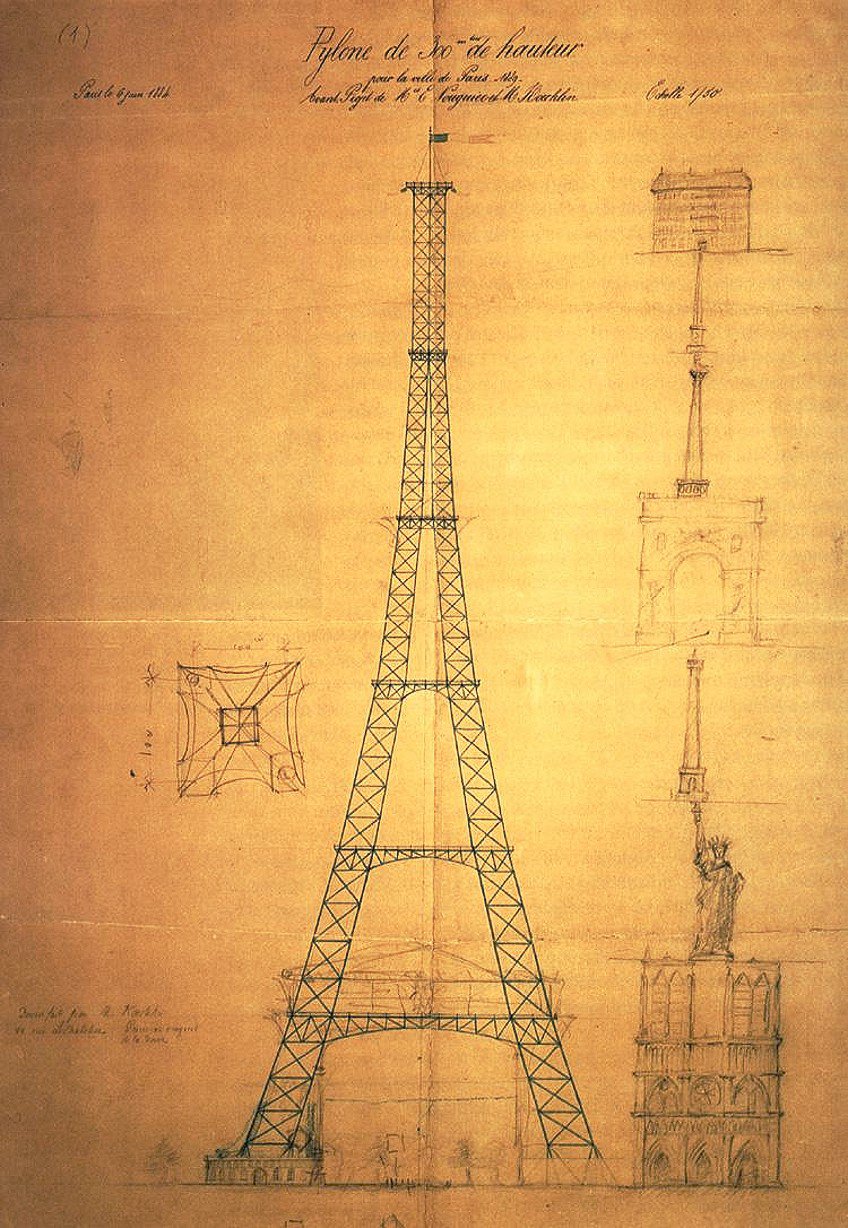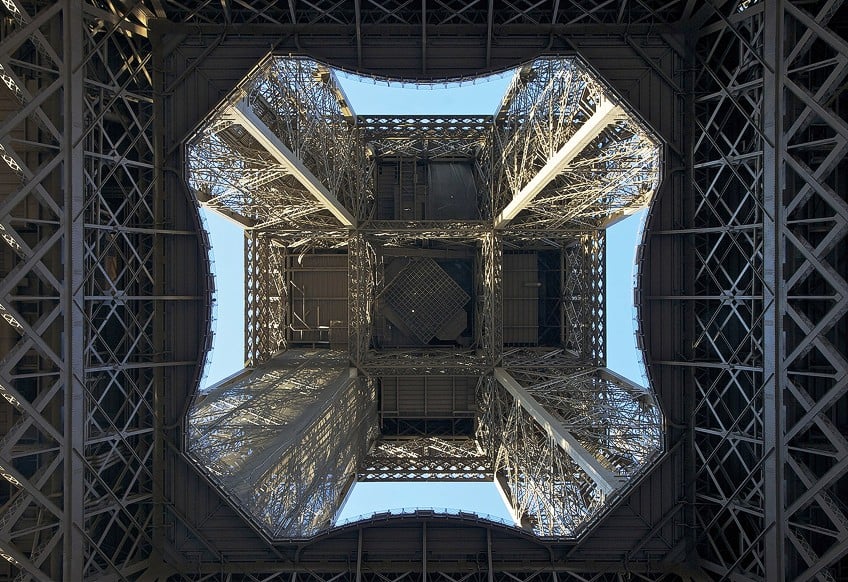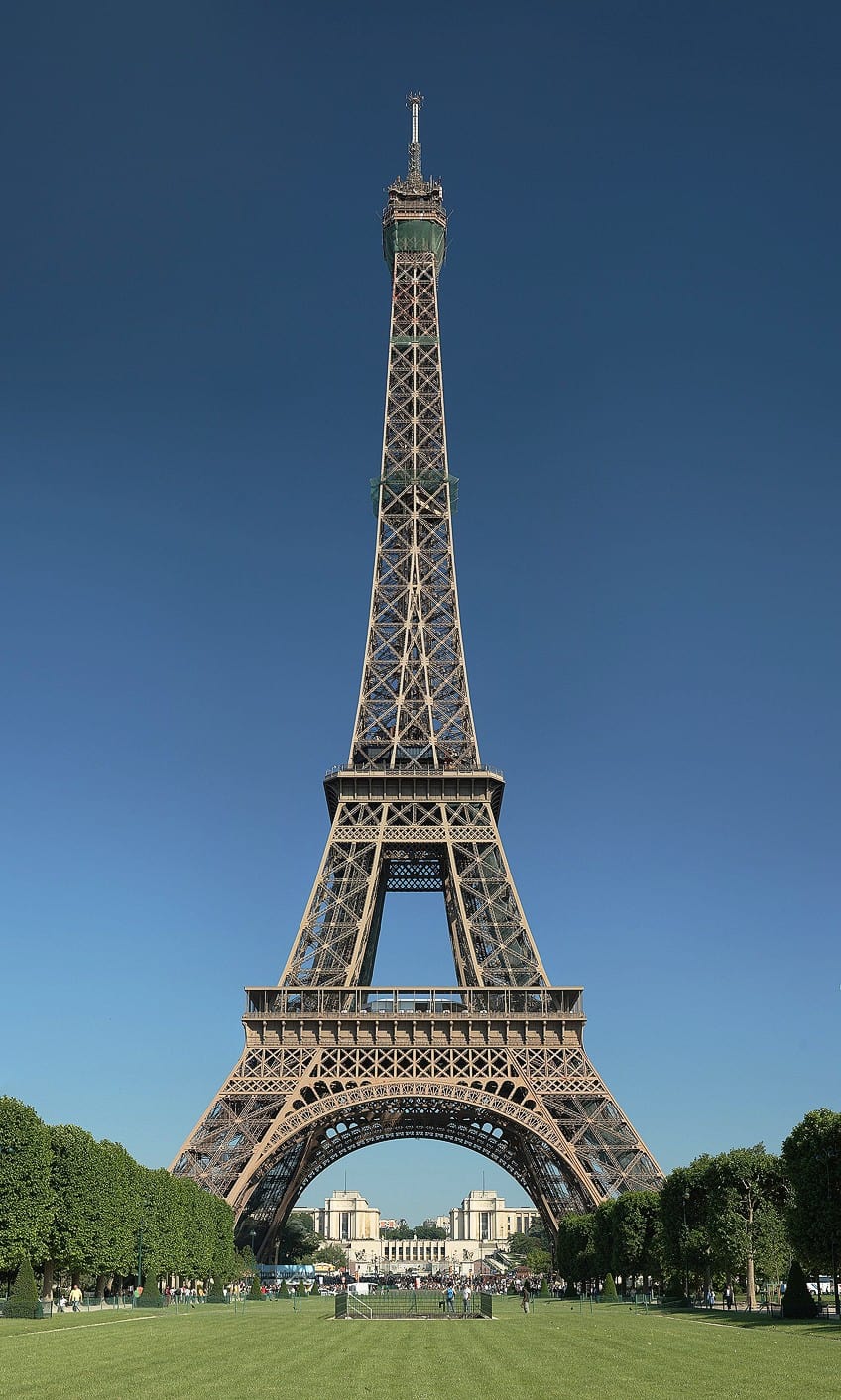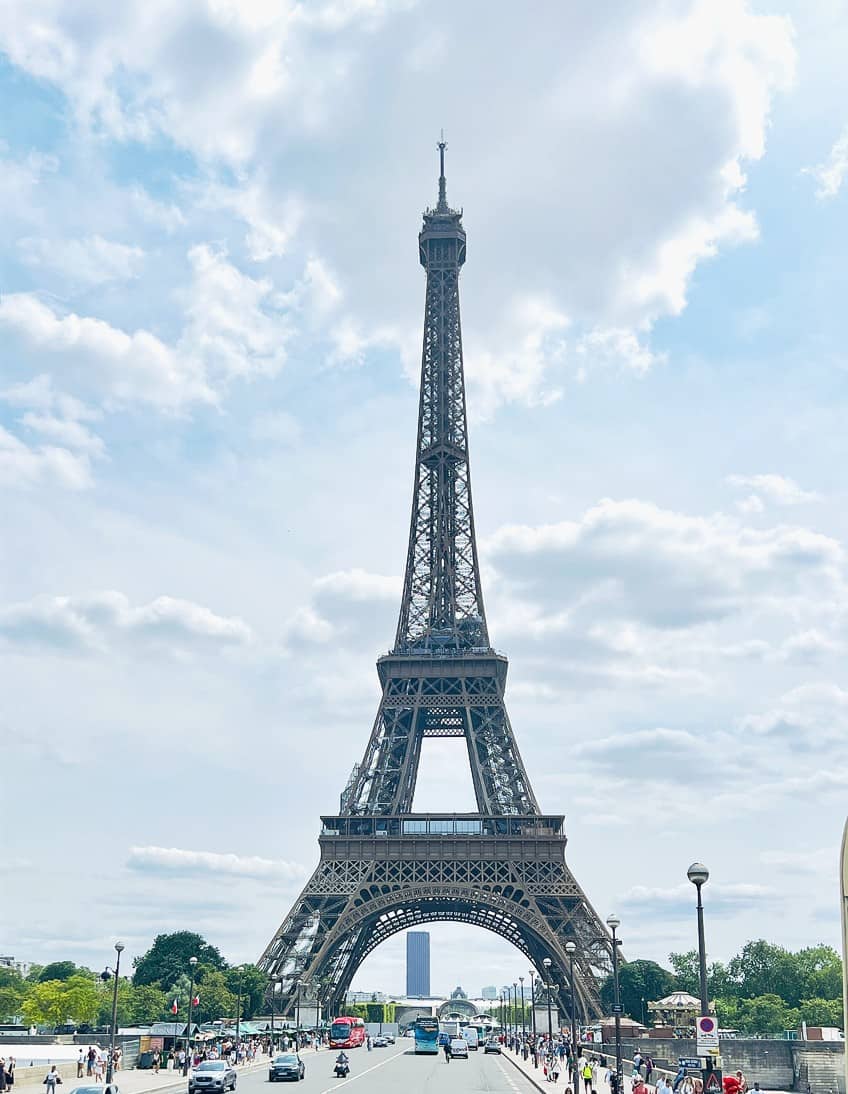Eiffel Tower in Paris – A Look at This Dazzling Landmark
The Eiffel Tower in Paris is one of the most famous buildings in the world. The image of this originally-temporary structure has become an icon of Paris, a city already famous throughout the world. Today, we are going to be looking at a few things about this famous Parisian monument, such as the Eiffel Tower’s history, its architecture, why it has the name that it now has, the Eiffel Tower’s height, the people who designed and built it, and a few additional Eiffel Tower facts that should be of interest. There is much to learn about this building, so let’s get started!
A Look at the Eiffel Tower in Paris
| Architect | Stephen Sauvestre (1849 – 1919), Maurice Koechlin (1856 – 1946), and Émile Nouguier (1840 – 1897) |
| Date Constructed | 1887 – 1889 |
| Original Function | 1889 World’s Fair entryway |
| Present Function | Tourist destination and broadcasting tower |
| Materials Used | Iron |
| Height | 330 meters (or 1,083 ft) |
| Location | Paris, France |
The Eiffel Tower in Paris is one of those buildings. It has become such a famous structure that one cannot imagine the city without it any longer. Structures like this are often located in cities for which the building is the most notable feature to most people, such as the Leaning Tower of Pisa which is, as the name suggests, located in the Italian city of Pisa. Everyone knows that town because of the immensely famous tower within its perimeter. The Eiffel Tower in Paris is somewhat unique because it was already an immensely famous place, and it would likely have remained famous had the Eiffel Tower come down when it was originally meant to come down, but seeing as it remained standing, it has become one of the most notable structures ever designed.
It’s impossible to disconnect Paris and the Eiffel Tower any longer, and for that reason, discussing it may seem like something of a fool’s errand.
However, who built the Eiffel Tower in Paris? Was it a person named Eiffel? Why was the Eiffel Tower built? Just for fun? How many floors is the Eiffel Tower? How many people died building the Eiffel Tower? This may be an extraordinarily famous monument, but that does not mean that we necessarily know all of these facts about it. That is what we are going to do today.

Let’s start with due diligence though and ask: what actually is the Eiffel Tower in Paris? This famous structure is a wrought-iron lattice tower. This means that it makes use of a lattice design, which is when one interlinks beams of wood or metal on top of each other while leaving gaps. This can, perhaps, best be seen in fences or climber structures for gardening. The lattice tower design has been emulated in a few other parts of the world, but none of those are anywhere near as famous as the Eiffel Tower itself.
The Eiffel Tower in Paris has also become one of the most iconic sights in the city and an integral part of the skyline.
It was actually criticized when it was first unveiled, but that will be discussed in some more detail below, and because of its place as one of the most notable locales in the world, it is also one of the most visited. There was a blip in visitors thanks to the Covid-19 pandemic, but the number of visitors has been rising again. Furthermore, the Eiffel Tower in Paris has become a UNESCO World Heritage Site. This symbol of Paris will likely remain in place for as long as Paris remains. It has managed to survive World Wars and a pandemic. It will probably continue to stand for a very long time. The Eiffel Tower’s history is definitely far from over. However, we should have a look at that history.
The Eiffel Tower’s History
The Eiffel Tower in Paris started its existence because of an important event in the city. That event was the 1889 World’s Fair. Every single World’s Fair has featured extraordinary structures that were designed purely for the exhibition, such as the Crystal Palace in London for the very first World’s Fair or the Barcelona Pavilion for one of the more notable 20th century World’s Fairs.
This particular World’s Fair would be no different, and Gustave Eiffel’s company took the project on board and got to work on the design. Much like many of the World’s Fairs in the past, there was not all that much time to prepare the site for what it needed to be used for, and so it only took a little over two years to complete the Eiffel Tower in Paris.
Construction officially started in 1887, the first level was completed the following year, the second level was completed a few months later, and the top of the building was completed the following year. The Eiffel Tower in Paris was officially opened on 31 March 1889. This is quite a remarkably quick timeline for the construction of what became the tallest building in the world upon its completion.

This meant that it was ready for its intended use in the World’s Fair in Paris. It lasted between May and October of 1889, and then it was over. It attracted millions of visitors, and the Eiffel Tower became a symbol of the exposition around the world. However, this particular World’s Fair was also considered to be a rather controversial one. It was specifically situated a century after the end of the French monarchy, and so it was used as a commemoration of that event. Thanks to that, many European countries that still had monarchies refused to take part. This didn’t stop many countries around the world, including a number of colonies, from taking part, but some of the biggest European countries simply boycotted it, such as Germany, Russia, the United Kingdom, and others.
Once the World’s Fair had come to an end, it was time for the Eiffel Tower in Paris to be dismantled. That had always been the plan. It was constructed as a temporary structure as many of the most famous World’s Fair buildings have been designed and implemented.
This never happened though. Today, it’s hard to imagine that anyone would think it was a good idea to demolish the Eiffel Tower, but that had been the plan. However, they decided against it. The structure had become one of the most popular sites in the city, and it still held the rank of the tallest building in the world. So, it simply stayed up.

There were many at the time who were vehemently against this. Many French artists and intellectuals found the tower to be an eyesore, and one of the most famous examples of this was Guy de Maupassant. This famous French writer claimed to have eaten his lunch in the restaurant atop the Eiffel Tower every single day for the remarkable reason that it was the only place in the city where one could not see the Eiffel Tower. This is an incredibly petty thing to do, but it has gone down in history as one of the funniest Eiffel Tower facts.
The hatred of the Eiffel Tower in Paris did eventually die down and the structure has since become an icon of the city, but it has also served other roles. In the early 20th century, it was used as an important radio tower in the region. It still serves that role to this day, but the Eiffel Tower has become more known as a tourist destination.
It was shut down to the public when the Nazi forces occupied the city during the Second World War, but ever since then, it has remained open to the public. It has seen numerous smaller additions over the years, such as a wind turbine and solar panels, and it has celebrated various milestones with light shows. However, today it has mostly remained a tourist spot where tourists can ascend to the very top and see some of the most stunning views possible. And that is the Eiffel Tower’s history.
The Eiffel Tower’s Architecture
The Eiffel Tower in Paris has become iconic, but the design itself was criticized by many of the artists who were mentioned above. The lattice design makes use of wrought iron, and there are four separate tiers that are laid out in a square formation with each level being narrower than the lower level. This brings the Eiffel Tower to a point at the very top of the structure.
The whole tower is set upon masonry columns to act as the foundation, and there are metal trusses to serve as support structures. The entire tower is then painted to reduce the risk of corrosion to the metal beneath it, and there are three main levels that can be visited.

There are two observation decks and a restaurant. The very top of the Eiffel Tower has been affixed with an antenna which, firstly, makes it a radio tower and, secondly, increased the height of the structure as a whole. When the Eiffel Tower in Paris was first constructed, it made use of iron because it was a representation of the Industrial Revolution’s progress. Iron was also the only material that could possibly support a structure of this design, and while contemporary structures may make use of steel, but that is not the case here even though steel was available at the time. Regardless of this, the tower has become one of the most important pieces of world architecture to have ever been designed. It has become an immensely iconic sight, and most can’t imagine Paris without this landmark.
The Eiffel Tower’s Name
The Eiffel Tower in Paris has become the most famous location in an already famous city, but the name of the structure has also become immensely famous. It is named after Gustave Eiffel, and thanks to his name on the structure, there has been a widespread misunderstanding that he was the designer of the building.
Gustave Eiffel was, after all, a civil engineer. He was an important figure in the use of metal frame designs like the lattice tower to which his name is attached.
However, as has been mentioned (and as will be further discussed below), he did not design the Eiffel Tower at all. He may have had a hand in some of the conceptualization of the structure as a whole, but he was not one of the architects or engineers involved in its construction.

The reason his name is attached is because he founded a company called Eiffel Constructions Métalliques (which still exists, but is now called Eiffage Métal), and this company was in charge of the design and construction of the Eiffel Tower in Paris. His employees were the ones who actually designed, engineered, and then built the structure. However, Gustave Eiffel’s name was forever attached to the structure, and it has become the most famous building to be associated with him.
The Eiffel Tower’s Height
The total height of the Eiffel Tower in Paris is 330 m (or 1,083 ft). This means that the building is roughly the equivalent of your average 81-story building. It is also the tallest structure in Paris and has remained that way ever since it was constructed. Nothing has been allowed to be taller than the Eiffel Tower, and specific regulations were put in place to ensure that this immensely famous building forever remains the tallest thing that Paris has ever seen.
However, the Eiffel Tower is made up of several floors. There are three primary floors. All of them can serve as observation decks, but they also generally have restaurants and other similar businesses within their walls. The first level is at a height of 57 m (or 187 ft), the second at 115 m (or 377 ft), and the third is 276 m (or 906 ft). Atop them all is a radio antenna that further increases the height.
When the Eiffel Tower in Paris was completed, it became the tallest building in the world, and this meant that it was able to beat out the Washington Monument in Washington D.C. in the United States. It would subsequently retain this record for just over four decades. It would ultimately lose its place as the tallest when the Chrysler Building came along.

The Chrysler Building was then surpassed by the Empire State Building a few months later and the tallest structure is now more than double the size of the Eiffel Tower. However, funnily enough, the addition of an elongated radio mast has actually made the Eiffel Tower taller than the Chrysler Building. So, while it will never be the tallest in the world again, it is taller than the building that took its place as the tallest structure in the world.
The Eiffel Tower’s Architects and Engineers
The Eiffel Tower in Paris, as has been mentioned, may hold the name of Gustave Eiffel, but he was not the man who designed it. Instead, it was designed by three figures at Eiffel’s company. These three men were:
- Stephen Sauvestre (26 December 1847 – 18 June 1919). This French architect was one of the architects who contributed to the general design of the Eiffel Tower. Some of his most important inclusions were the use of decorative arches, the color of the tower in general, and the addition of a glass pavilion on the first level. He would later go on to become the head of architecture at the company.
- Maurice Koechlin (8 March 1856 – 14 January 1946). This Franco-Swiss structural engineer was a member of the immensely famous Koechlin family. He spent the vast majority of his career at Eiffel’s company, and he would have a hand in the design of other structures, such as the Statue of Liberty.
- Émile Nouguier (17 February 1840 – 23 November 1897). This French civil engineer and architect was one of those who worked on the Eiffel Tower, but he also had a hand in structures like the Garabit Viaduct bridge.
And these were the three men who actually designed the Eiffel Tower in Paris. Their work is not as known today because their name is not forever affixed to the structure that they designed, but they did all achieve considerable fame throughout their lives regardless of that.
A Few Additional Eiffel Tower Facts
Let’s have a look at a few interesting Eiffel Tower facts. Below, we will examine only a few additional points that should be interesting for those who want to know just that little bit more about one of the most famous landmarks to have ever been designed.
- There is a secret apartment at the very top. This apartment was added at the behest of Gustave Eiffel so that he could entertain high-profile guests. It is made up of a bedroom, living room, kitchen, and bathroom.
- When the Nazis occupied Paris, they wanted to destroy it. This order was never carried out, but Hitler personally ordered the destruction of the iconic Parisian landmark. Luckily, it remained standing through it all.
- The tower’s first bungee jump took place in 1987. This first bungee jump was actually illegally performed off the second level of the Eiffel Tower, and the man responsible was arrested because of it.
- The first marriage in the Eiffel Tower was in 2007. The wedding was part of a package offered by a French radio station. The contest was won by two Americans, who traveled to the tower for their nuptials.
- The first vertical race up the tower took place in 2014. This vertical race involved running up the over 1,600 stairs of the Eiffel Tower instead of using the elevator. There have been other vertical races up the structure since then.
And that is our look at a few additional Eiffel Tower facts. There are doubtless many more worth knowing, but this has been a short and sweet list. Hopefully, it has been enough to whet your appetite for some Eiffel Tower facts.

And that is all we have to say about the Eiffel Tower in Paris! We have examined the tower’s history, the architecture of the site, the Eiffel Tower’s height, and several other points. Hopefully, you learned a good deal about one of the most famous landmarks in the world today, but there is always more to learn out there and many other structures to discuss.
Frequently Asked Questions
What Is the Eiffel Tower in Paris?
The Eiffel Tower is a landmark structure in Paris. The original purpose of this incredibly famous structure was to serve as the entryway into the World’s Fair in Paris in 1889. However, the tower was never pulled down, as it was meant to, and it instead remained in the city and became one of the most iconic buildings in the world. It has been open to the public for most of its existence.
Who Built the Eiffel Tower in Paris?
The Eiffel Tower in Paris was built by Gustave Eiffel’s company, but not actually by Eiffel himself. It was designed by several others but has become synonymous with him because it shares his name. The people who actually designed it were Maurice Koechlin, Emile Nouguier, and Stephen Sauvestre.
Why Was the Eiffel Tower Built?
The original purpose of the Eiffel Tower in Paris was to serve as a commemoration of the French Revolution, and to be the entryway to the World’s Fair in Paris the year it was completed. It was never pulled down and instead became an icon of Paris and an important tourist destination.
How Many Floors Is the Eiffel Tower?
The Eiffel Tower in Paris contains three primary floors. The first is 57 m (or 187 ft) up and includes a restaurant and exhibition space. The second floor is 115 m (or 377 ft) up and is an observation deck, restaurant, and a dessert bakery. The third floor is 276 m (or 906 ft) up and includes an observation deck, bar, and a recreation of Gustave Eiffel’s office. The full height of the Eiffel Tower is 330 m (or 1,083 ft).
How Many People Died Building the Eiffel Tower?
The Eiffel Tower in Paris made use of a relatively small workforce of about 300 builders, and while there were several people who contracted diseases during construction and died, there were very few deaths because of accidents. However, the sources on this are often contradictory. Some claim that only one died, others say that none died, and others state that anywhere from five to twenty people died.
Justin van Huyssteen is a writer, academic, and educator from Cape Town, South Africa. He holds a master’s degree in Theory of Literature. His primary focus in this field is the analysis of artistic objects through a number of theoretical lenses. His predominant theoretical areas of interest include narratology and critical theory in general, with a particular focus on animal studies. Other than academia, he is a novelist, game reviewer, and freelance writer. Justin’s preferred architectural movements include the more modern and postmodern types of architecture, such as Bauhaus, Art Nouveau, Art Deco, Brutalist, and Futurist varieties like sustainable architecture. Justin is working for artfilemagazine as an author and content writer since 2022. He is responsible for all blog posts about architecture.
Learn more about Justin van Huyssteen and about us.
Cite this Article
Justin, van Huyssteen, “Eiffel Tower in Paris – A Look at This Dazzling Landmark.” artfilemagazine – Your Online Art Source. September 20, 2023. URL: https://artfilemagazine.com/eiffel-tower-in-paris/
van Huyssteen, J. (2023, 20 September). Eiffel Tower in Paris – A Look at This Dazzling Landmark. artfilemagazine – Your Online Art Source. https://artfilemagazine.com/eiffel-tower-in-paris/
van Huyssteen, Justin. “Eiffel Tower in Paris – A Look at This Dazzling Landmark.” artfilemagazine – Your Online Art Source, September 20, 2023. https://artfilemagazine.com/eiffel-tower-in-paris/.



